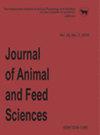壳聚糖在不同水平上处理苜蓿青贮饲料以测定化学、营养、发酵和微生物参数
IF 1.5
4区 农林科学
Q3 AGRICULTURE, DAIRY & ANIMAL SCIENCE
引用次数: 1
摘要
。壳聚糖是一种可生物降解、抗微生物、抗真菌的多糖,因此在不同的工业中用作添加剂。研究了添加壳聚糖对紫花苜蓿青贮品质性状的影响。在苜蓿青贮饲料中添加4个不同水平的壳聚糖:0% - CONT组;0.5% - CHTS0.5组;1% - CHTS1.0组;2% - CHTS2.0组。CHTS 2.0组中性洗涤纤维(NDF)和中性洗涤不溶性粗蛋白(NDICP)均显著升高(P < 0.05)。壳聚糖处理降低了乳酸和丁酸含量(P < 0.05),提高了乙酸和丙酸含量(P < 0.05)。在打开青贮当天,添加壳聚糖组没有霉菌产生,酵母产生减少。在打开青贮后5天,添加壳聚糖组的酵母产量过高,但未见霉菌发育。壳聚糖处理提高了青贮pH值(P < 0.05)。由此可见,壳聚糖对苜蓿青贮发酵品质有负面影响,但抑制了霉菌和梭菌的发育。本文章由计算机程序翻译,如有差异,请以英文原文为准。
Treatment of alfalfa silage with chitosan at different levels
to determine chemical, nutritional, fermentation,
and microbial parameters
. Chitosan is a biodegradable, antimicrobial, antifungal polysac-charide, thus used as an additive in different industries. Effects of chitosan supplementations on silage quality traits of alfalfa were investigated in the present study. Chitosan was supplemented into alfalfa silages at four different levels: 0% – CONT group; 0.5% – CHTS0.5 group; 1% – CHTS1.0 group; and 2% – CHTS2.0 group. Neutral detergent fibre (NDF) and neutral detergent insoluble crude protein (NDICP) values increase in CHTS 2.0 group ( P < 0.05). Lactic acid and butyric acid contents decreased ( P < 0.05), acetic and propionic acid contents increased with chitosan treatments. On the day of opening the silages, mould production was not encountered, and yeast production decreased in chitosan-supplemented groups. Excessive yeast production was encountered, but mould development was not seen in chitosan-supplemented groups 5 days after opening the silages. Silage pH values increased with chitosan treatments ( P < 0.05). So, it can be concluded that chitosan negatively influenced fermen tation quality of alfalfa silage, but reduced mould and clostridial development.
求助全文
通过发布文献求助,成功后即可免费获取论文全文。
去求助
来源期刊

Journal of Animal and Feed Sciences
农林科学-奶制品与动物科学
CiteScore
2.10
自引率
0.00%
发文量
42
审稿时长
3 months
期刊介绍:
Journal of Animal and Feed Sciences (JAFS, J. Anim. Feed Sci.) has been published by the Kielanowski Institute of Animal Physiology and Nutrition, Polish Academy of Sciences in Jabłonna (Poland) since 1991. It is a continuation of the Polish-language journal Roczniki Nauk Rolniczych. Seria B, Zootechniczna published by the Polish Academy of Sciences since 1969.
JAFS is an international scientific journal published quarterly, about 40 papers per year including original papers, short communications and occasionally reviews. All papers are peer-reviewed and related to basic and applied researches in the field of animal breeding and genetics, physiology of nutrition, animal feeding, feed technology and food preservation. The journal distinguishes the multidisciplinary nature of physiological and nutritional sciences and so includes papers specialized in all fields connected with animal well-being, including molecular and cell biology and the emerging area of genetics.
 求助内容:
求助内容: 应助结果提醒方式:
应助结果提醒方式:


